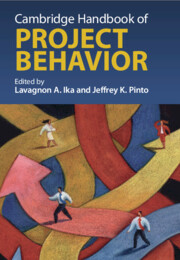Introduction
Published online by Cambridge University Press: 22 November 2025
Summary
Projects tend to have a complicated life (or “behavior”) of their own with plenty of out-turns, going off track, and, in the end, targets set may be realized anywhere but on target, from near misses to near hits. Therefore, the project behavior phenomenon abounds in project management theory and practice. However, while scholars see the need to understand project challenges within the context of project behavior, they fail to follow the trail to its defining principles. Against this backdrop, this handbook focuses on the observance of the project behavior phenomenon in which there are systematic deviations between project initiation and execution. This introductory chapter explains what project behavior is and why it matters for project management scholars and practitioners alike. It reviews the key principles of project behavior and how they each connect to project complexity, risk, uncertainty, and performance, from both a scholarly and practical standpoint. It provides not only a historical context for the different theories of project behavior but a typology. As well, it offers a summary of the chapters in the handbook and discusses how they advance project behavior theory and practice.
Information
- Type
- Chapter
- Information
- Cambridge Handbook of Project Behavior , pp. 1 - 24Publisher: Cambridge University PressPrint publication year: 2025
References
Accessibility standard: WCAG 2.0 A
Why this information is here
This section outlines the accessibility features of this content - including support for screen readers, full keyboard navigation and high-contrast display options. This may not be relevant for you.Accessibility Information
Content Navigation
Allows you to navigate directly to chapters, sections, or non‐text items through a linked table of contents, reducing the need for extensive scrolling.
Provides an interactive index, letting you go straight to where a term or subject appears in the text without manual searching.
Reading Order & Textual Equivalents
You will encounter all content (including footnotes, captions, etc.) in a clear, sequential flow, making it easier to follow with assistive tools like screen readers.
You get concise descriptions (for images, charts, or media clips), ensuring you do not miss crucial information when visual or audio elements are not accessible.
You get more than just short alt text: you have comprehensive text equivalents, transcripts, captions, or audio descriptions for substantial non‐text content, which is especially helpful for complex visuals or multimedia.
You can access graphs or charts in a text or tabular format, so you are not excluded if you cannot process visual displays.
Visual Accessibility
You will still understand key ideas or prompts without relying solely on colour, which is especially helpful if you have colour vision deficiencies.
You benefit from high‐contrast text, which improves legibility if you have low vision or if you are reading in less‐than‐ideal lighting conditions.
